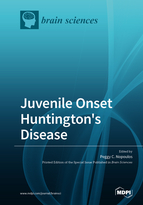Juvenile Onset Huntington's Disease
A special issue of Brain Sciences (ISSN 2076-3425).
Deadline for manuscript submissions: closed (30 June 2020) | Viewed by 32729
Special Issue Editor
Special Issue Information
Dear Colleagues,
The single-gene disorder, Huntington’s disease (HD), is experiencing tremendous advances with current phase III clinical trials for gene knock-down therapy (antisense oligonucleotide) and several more in the pipeline. Yet, in the HD community, there is a cohort of patients who are suffering but excluded from the excitement of these clinical trials—children who have early onset disease. Juvenile Huntington’s disease (JHD) is defined as onset of the disease prior to the age of 21 years. Many patients with JHD are eventually adults who can qualify for gene trials; however, they are often excluded due to severity of illness. Pediatric HD (PHD) is the term used to describe young people affected by HD who are currently <18 years of age. These subjects, due to their age alone, are also excluded from clinical trials. Even if PHD and JHD were eligible for trials, though, there are serious gaps in our understanding of early onset HD. In particular, the motor phenotype is strikingly different from typical adult onset HD. Yet basic questions of pathophysiology remain unanswered—how is early onset HD similar to typical adult onset HD, and how is it different? Are there symptoms unique to early onset HD? What are the appropriate biomarkers for disease progression in early onset HD? This Special Issue aims at providing an overview of topics—both clinical and research—on this rare and unique patient sample.
Prof. Peggy C. Nopoulos
Guest Editor
Manuscript Submission Information
Manuscripts should be submitted online at www.mdpi.com by registering and logging in to this website. Once you are registered, click here to go to the submission form. Manuscripts can be submitted until the deadline. All submissions that pass pre-check are peer-reviewed. Accepted papers will be published continuously in the journal (as soon as accepted) and will be listed together on the special issue website. Research articles, review articles as well as short communications are invited. For planned papers, a title and short abstract (about 100 words) can be sent to the Editorial Office for announcement on this website.
Submitted manuscripts should not have been published previously, nor be under consideration for publication elsewhere (except conference proceedings papers). All manuscripts are thoroughly refereed through a single-blind peer-review process. A guide for authors and other relevant information for submission of manuscripts is available on the Instructions for Authors page. Brain Sciences is an international peer-reviewed open access monthly journal published by MDPI.
Please visit the Instructions for Authors page before submitting a manuscript. The Article Processing Charge (APC) for publication in this open access journal is 2200 CHF (Swiss Francs). Submitted papers should be well formatted and use good English. Authors may use MDPI's English editing service prior to publication or during author revisions.
Keywords
- Huntington’s Disease
- biomarkers
- HD
- JHD
- typical adult onset HD
- early onset HD







